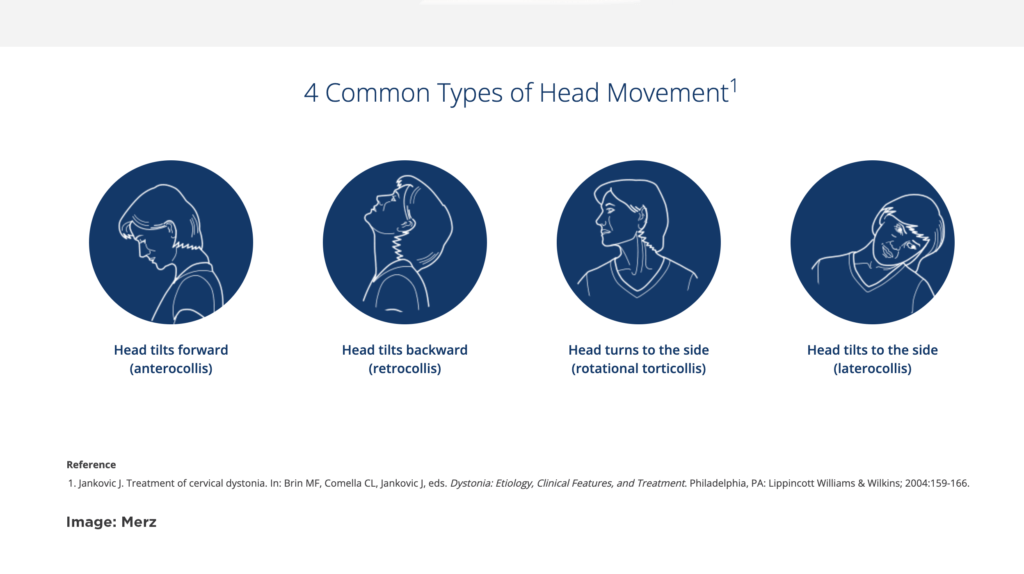
What Is Cervical Dystonia?
by Natalie Diaz
What is cervical dystonia?
Cervical dystonia is a localized, or focal, form of a neurological condition called dystonia. It is a very common movement disorder that affects mostly the muscles of the head and neck. Cervical dystonia causes involuntary contractures or involuntary activation of muscles in the neck, such as twisting or turning of the neck, and sometimes results in an abnormal posture. This posture can pull the head back or it can pull the head, rotating the head to one side. It can also tilt the head to one side, or sometimes even pull it forward.
What are the symptoms of cervical dystonia?
Some patients may have cervical dystonia and not know it. However, in most instances, cervical dystonia causes symptoms. One may feel pulling or twisting, experience a decreased range of motion of the neck, or feel stuck in a certain posture.
Occasionally, in the beginning stages of cervical dystonia, patients may experience tremor of the neck. Most often, cervical dystonia causes some degree of pain, which can sometimes be severe.

Who is at risk of cervical dystonia?
Cervical dystonia tends to happen more in men and women. We don’t know the cause of cervical dystonia, although research suggests there may be a genetic component to it.
On occasions, cervical dystonia may be caused by trauma of the head or neck, or by certain medications that block dopamine. We call these types of medications neuroleptics. For someone who is susceptible to cervical dystonia, neuroleptics may cause cervical dystonia to arise.
Is there a cure for cervical dystonia?
Cervical dystonia is a chronic, or long-term condition. Luckily, there are several ways that we can treat cervical dystonia once we identity that someone is living with and experiencing the condition.
The most effective way to treat cervical dystonia is through injections of botulinum toxins, such as Botox and Zymin, or several other compounds. These types of injections are muscle relaxers. They are injected directly into the muscles identified as the “culprit” to help try to relax the muscles, bringing the neck back into a normal position, helping open up the range of motion, and reducing pain for the patient.
Sometimes, we use oral medications if the injections of botulinum toxins are not fully relaxing the muscles. A combination of injections and oral medications often helps those with cervical dystonia reduce their pain, improve their neck mobility, and improve their quality of life.
Treating Dystonia with Botox
Listen to Dr. Diaz on The Think Neuro Podcast mini talk about how botox can ease can help ease the symptoms.

About Pacific Movement Disorders Center
Pacific Movement Disorders Center offers surgical and non-surgical options for dystonia. Properly managing movement disorders must include both education and support. With informational programs, support groups, psychological care, and caregiver guidance, we’re with you at every step. Our partnership with American Parkinson’s Disease Association (APDA) also provides structured support groups for newly diagnosed PD patients and their families.
Pacific Movement Disorders Locations

The Pacific Movement Disorders Center’s state-of-the-art facilities are located at:
Providence Saint John’s Health Center
2125 Arizona Ave, Santa Monica, CA 90404
310-829-8265
Providence Little Company of Mary Medical Center Torrance
5215 Torrance Blvd, Suite 300, Torrance, CA 90503
424-212-5361
About Dr. Natalie Diaz

Natalie Diaz, MD, Dr. Natalie Diaz is a board-certified neurologist with fellowship training in movement disorders. Her clinical practice focuses on the evaluation and management of patients with Parkinson’s disease, atypical parkinsonian disorders, Huntington’s disease and other choreiform disorders, dystonia, and ataxia. She also has specialized training in the evaluation and programming of deep brain stimulation as a treatment for Parkinson’s disease, essential tremor and dystonia as well as the therapeutic administration of botulinum toxin injections for non-cosmetic indications such as focal dystonia, hemifacial spasm and limb spasticity. Her research focuses on industry-sponsored clinical trials in Parkinson’s disease and other collaborative clinical projects in the field of neurodegenerative disorders.
What Patients Are Saying

I’m very happy with Dr. Diaz. She is friendly and easy to talk to. She’s very knowledgeable and gives you a lot of information for you to make choices that fit both what you’re comfortable with and what you need. She takes the time to answer all your questions and doesn’t rush your appointment.
View on Healthgrades.com
For more information about cervical dystonia, please visit:
https://www.ninds.nih.gov/disorders/dystonias/detail_dystonias.htm
https://rarediseases.info.nih.gov/diseases/10668/cervical-dystonia
https://www.torticollis.org
www.pacificmovement.org
Read More About Dystonia
About the Author

Natalie Diaz
Natalie Diaz, MD, is a board-certified neurologist with fellowship training in movement disorders. Her clinical practice focuses on the evaluation and management of patients with Parkinson’s disease, atypical Parkinsonism disorders, Huntington’s disease and other choreiform disorders, dystonia, and ataxia.
Last updated: November 6th, 2024


